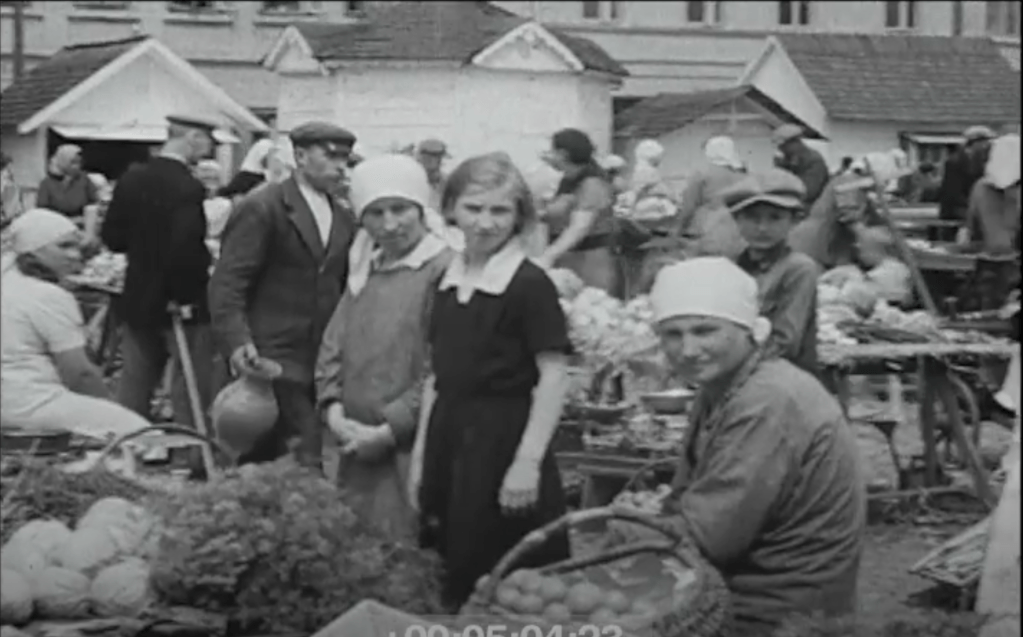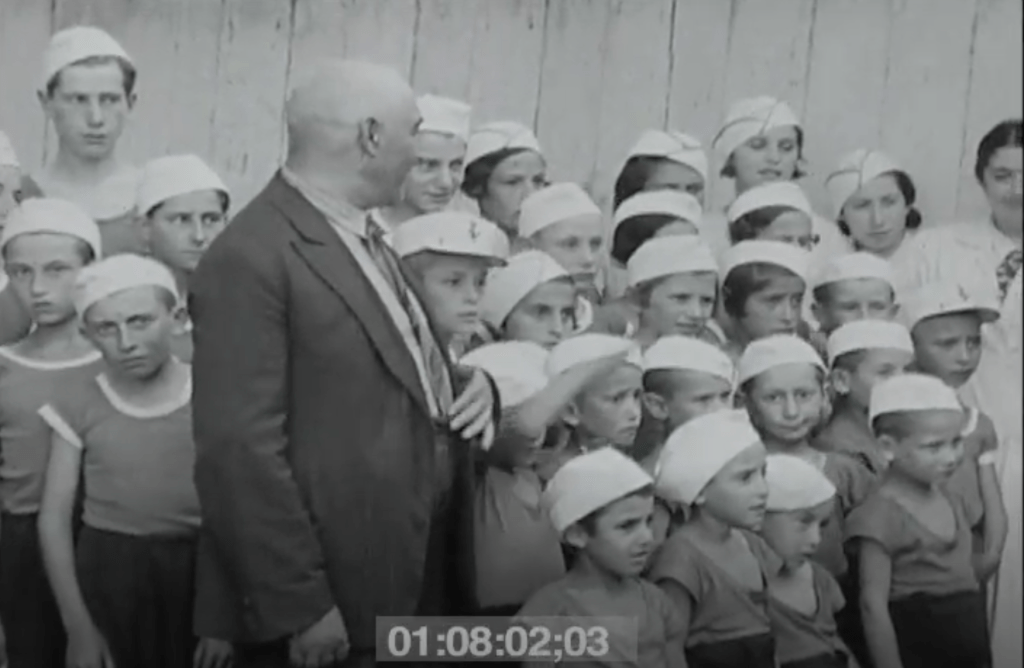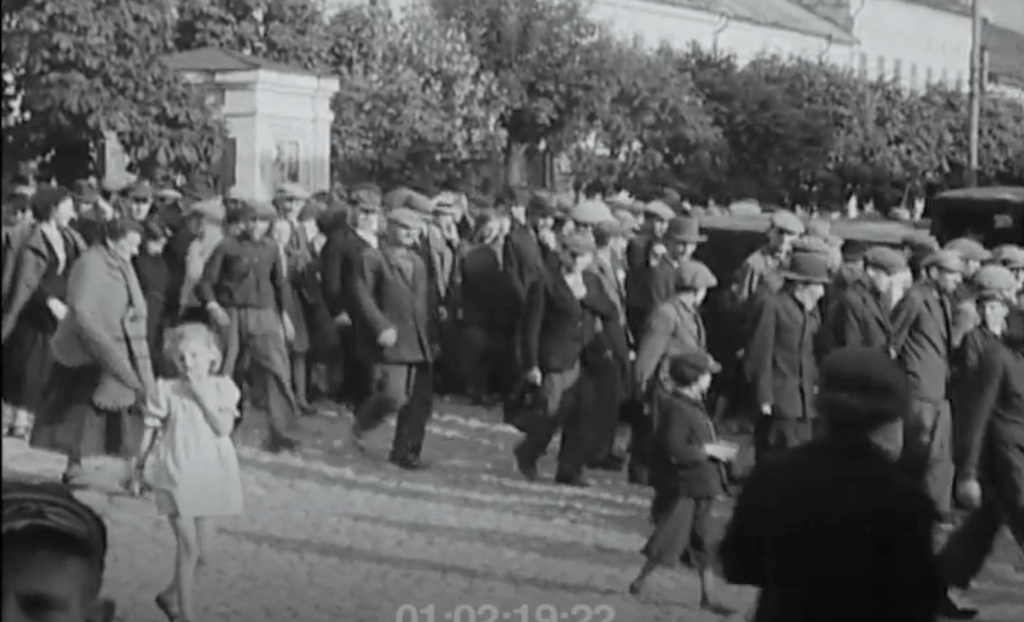In the summer of 2002, I went on a winding journey from Berlin northwest to Mecklenburg–Western Pomerania in Germany, then east through Gdańsk and Białystok in Poland, to ultimately reach the town of Suwałki in northeast Poland. This route had been charted by my mother to follow our family tree, seeking out each place named among her Christian German ancestors (via her father Carl) and her Polish Jewish ancestors (via her mother Ruth). My fascination with the Polish labor-uprising-turned-democracy-movement Solidarity had added Gdańsk to the itinerary.
My mother’s genealogical travelogue for the journey is fabulously detailed, naming each place we visited, meal we had, and fruit we tasted. After sharing a dinner of bread, cheese, and fruit in a park, we took a late night train from Gdańsk at 12:50am. It being the Corpus Christi holiday, the train car was crowded with late-night revelers and we had to step off the train at another stop to find our sectioned-off sleeper car. Traveling no more than 35 miles per hour, and changing trains in Bialystok we made it Suwałki by midday.
My grandmother Ruth, her five sisters and one brother, were born in Cleveland to Kalmos Rubenstein and Minnie Gottlieb Rubenstein, from 1901 to 194. Their parents, in turn, had been born in the late 1870s in the Suwałki governorate, both Jewish subjects of the Russian Empire. The records my mom compiled indicate they married in Russia in 1900 before embarking on the journey across the Atlantic. A history of the Jews of Suwalki suggests many ups and downs as Jews surged into the area fleeing pogroms deeper in Russia, played a major role in the economy, and built dozens if not scores of community institutions in the town. South of Suwałki, the Russian Empire helped organize the vicious Białystok Pogrom of 1906. But the great looming disaster of the region was of course the Nazi invasion of 1939 and the extermination campaign against Jews that followed.
In Vorpommern, near the Baltic Sea, my mother and I had stopped in the churchyards of a handwritten list of towns. In their cemeteries, often small plots that were used again and again over the centuries, we scanned the gravestones for familiar surnames. Often we found these most by the low stone walls on the edge of the cemetery, where the oldest headstones were moved and stacked up once they were on the verge of being forgotten. In Suwałki, however, this was a different experience. As my mom recorded (all text is purple is hers),
We returned to Suwalki and went to the Jewish cemetery. There are a few grave markers left in this very large field. However, since the Nazis destroyed most of the cemetery and used the stones for roads and walkways, there were few stones left. The people of Suwalki did take the remaining ones and created a wall of the stones to honor the Jewish people. The only other Jewish structure remaining in Suwalki was the Yeshiva.
This cemetery stood as a metaphor for just how close we had come, and just how far we stood from her family, to her second cousins (she was born in 1936) and relatives beyond murdered in the Shoah. So did the presumably Catholic Poles who shared the weekend sunshine with us that late May day:
This is a very beautiful area of Poland. There are many lakes and it is now a great recreation and camping area. We arrived there on Corpus Christi Day and the train was very crowded with people coming to vacation and many to camp. Our guide […] met us at the train and drove us around the area. We went first to Kaletnik where the Gottlieb family resided. We went through beautiful forests with mostly fir trees and then farmland. Kaletnik is a small town with a Catholic Church and cemetery. The graves were all decorated with flowers. The town overlooks a lake. We were very close to the Lithuanian border, but could not cross it because we did not have a visa. Since this was a holiday, the people were walking on the roads, riding their bicycles, or picnicking with their families. We were not able to talk with them.
In Kaletnik’s graveyard, all the graves we found were marked by crosses. The faces, their “blue eyes and blond hair” did not read as Jewish and seemed, as she wrote, confirmation that “Hitler achieved what he set out to do.” The rural lives we saw being lived didn’t match her expectations.
Even though I was not able to find any new information on our family (I did not expect to), I felt close to them. I was able to picture the area they came from. However, I cannot picture them as farmers. Maybe they were shopkeepers or something else in town.
Four years earlier, we had sought out the town of Suwalki in a book of survivors’ names in Washington’s Holocaust Museum; there had been no entries beneath it.
At the furthest point of our travels, then, we reached the abyss, still craving some recognizable way to envision the lives we could never reach.
Until a few weeks ago, in my living room.
Unexpectedly, the PBS documentary The U.S. and the Holocaust (2022) includes home movies from another immigrant family, the Chicago-based couple Lottie and Herman Bland, and their children, who made the same journey we had. But they went at one of the last possible moments to see Jewish life, in the summer of 1937, when Suwałki was part of unoccupied Poland.





I watched, and rewatched, and rewatched the few minutes in the PBS documentary. I found the Bland’s video collection archived online by the United States Holocaust Memorial Museum. And I instinctively reached for my phone to call my mom. Who died last November.
This would have been the end of the rainbow she had been constructing for years, the family lore she wrote down, and the letters sent with small money orders asking for a ship’s manifest or to locate a given person in a given archive.
To see them as they lived, before the Nazi genocide.
Family records only mark my great grandfather Kalmos Rubenstein’s occupation as “junk man” and one can imagine him among the peddlers with carts in a Suwalki square, three decades before this video. The silent film records the poor and the rich of Suwałki’s Jews, the street vendors, the orphanage, the great crowds of the city, the elders emerging from an old age home, the businessman posing with Mr. Bland. And the Blands reuniting with cousins, smiling at the camera, loving embraces of a young couple.
Two years later, after the Polish invasion of September 1939. Kasriel Eilender’s history details the various waves of violence, of furtive escapes to elsewhere in Poland or into Soviet territory. By 1942, Lithuania, Latvia, Estonia, Belarus, and parts of Russia had been overrun, so wherever they went they remained under Nazi occupation. A final three thousand, Eilender records, were taken to nearby forest and shot. Likewise were 2,000 Suwałki Jews killed in Slonim, Belarus.
***
Of course, we still live in unfathomable times. And, one by one, each feature of Jewish suffering in Europe seems to acquire its reflection in Palestine.
Seven weeks before I walked with my mother in Suwałki and Kaletnik, the Israeli military had invaded Jenin and shattered any illusion of autonomy for the Palestinian Authority, whose presidential compound itself was besieged. The battle marked the emergence of bulldozer as weapon, destroying completely 140 buildings and damaging 200 more. In a report I still recall, an Israeli military officer had advised his troops to study Nazi tactics: “If our job is to seize a densely packed refugee camp or take over the Nablus casbah, and if this job is given to an (Israeli) officer to carry out without casualties on both sides, he must before all else analyse and bring together the lessons of past battles, even — shocking though this might
appear — to analyse how the German army operated in the Warsaw ghetto.”
A reflection, but not yet a full mirror in 2002.
As I journaled in Krakow, “Our cousins are recycling 1930’s hell for the Palestinians (you remember the 30’s, right? When there were no death camps but Jewish suffering was still unacceptable from the standpoint of justice and ignorable from the standpoint of the American government).”
Now though, in 2024, I can’t see the film of everyday life in Suwałki and not also see the unarchived stream of home videos and photos reaching us from Gaza. A good portion of which are just Palestinian life, as lived outside the genocide.
As I write this, thirty thousand names have been recorded by Palestinian health officials, naming the dead who have been identified in hospitals, cemeteries, and morgues. Sixteen Gaza cemeteries have been desecrated or destroyed. The future of life in Gaza is very much in the conditional tense.

